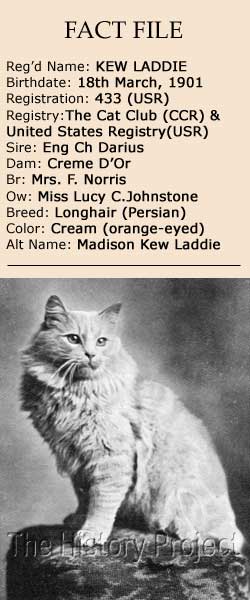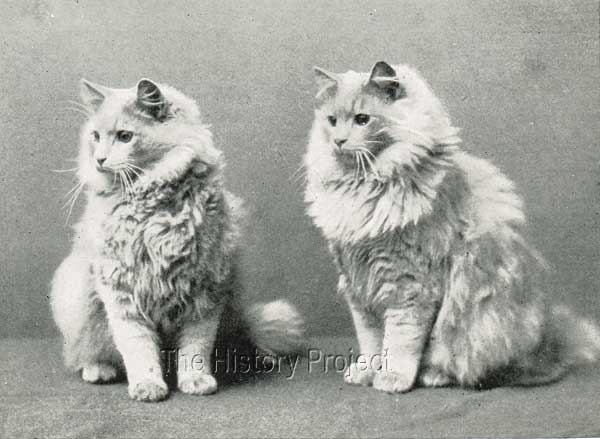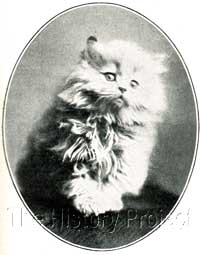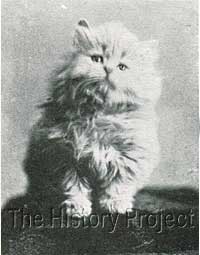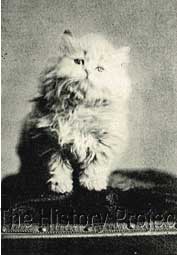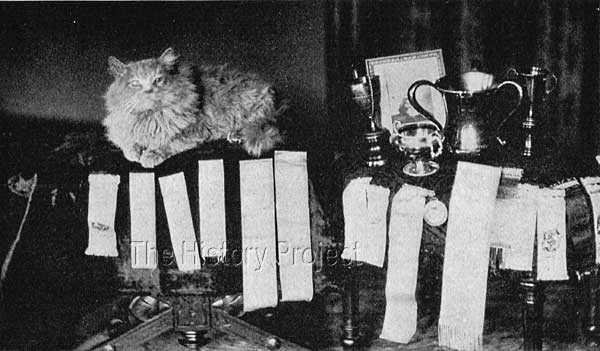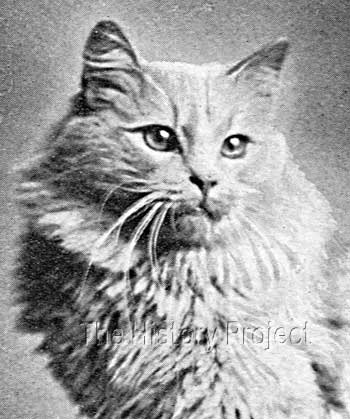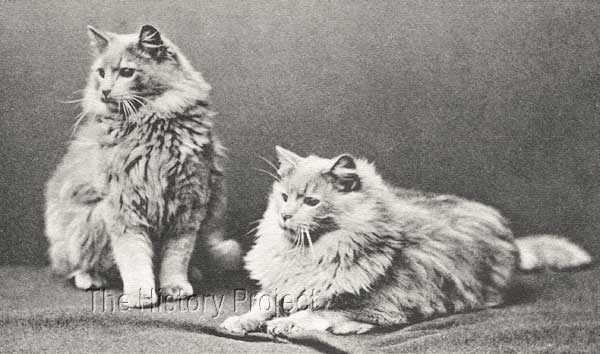 | ||||||||||||||||||||||||||









|
KEW LADDIE (1901)PHOTOS | SOCIAL MEDIA | REFERENCES
HISTORICAL BACKGROUND:Kew Laddie was one of the very first Cream Persians bred in England to make a significant impact on the Persian show scene in the United States. The earliest creams were generally referred to as "Fawns" and were most often the result of breeding a Blue male to a Tortie, the subsequent Cream progeny being only males. The colour was generally 'hot' and uneven. When Cream males were retained as studs, and bred to both Blue and Blue-cream females, paler more even coats resulted and in the case of Cream to Blue-cream, or Cream to Tortie, Cream females were produced. The rarity of Cream females was due to the fact that in those days, the genetics of the sex-linked "o" gene was not understood, and hence the misunderstanding of why Torties were almost always female, and the futile rage to keep and attempt to perpetuate the existence of Tortie males. The aim, was to breed pale, unmarked Creams, with little or no hint of tabby barring and free of any white spotting. Among the earliest breeders of Creams of note was the famous Romaldkirk Cattery of the Misses Beal, from which came a notable litter containing two remarkable early males, who made an immense mark on establishing the Cream as a recognized and sought-after colour variety. These were namely Romaldkirk Admiral and Romaldkirk Midshipmite (1896), who were never known to be shown in anything but superb coat and condition, becoming commonly referred to as 'The Heavenly Twins'. On the colour of Creams and the difficulties of breeding cats of sound colour, the following notes are from the renowned breeder and judge of Cream Persians, Mr Frank Norris (of Kew Cattery): "Cream cats are of a modern colour in Persians, but are now being more freely bred and finding numerous supporters. There are however, very few good ones in the fancy, for size, and colour are difficult to obtain. The great failing with them is that, although they are called cream cats, the best and soundest coloured ones are really of a fawn shade. So many show markings, patches, or shadings, whereas the colour should be one shade and sound throughout; better to be a little dark in colour rather than shade from cream to white, as is the case with so many specimens exhibited.1 " PARENTAGE & OWNERSHIP:Mrs. Frank Norris of "Kew" cattery fame, came into possession of one rare Cream female, initially bred by Mrs. Milner in 1899, from a pairing of 'Ch.Romaldkirk Admiral (1896)' and 'Sister'. This female was 'Crème d'Or', who had formerly been owned by Mrs Wellbye. This queen had developed a reputation for being difficult to breed, being inclined to refuse to enter into any sort of matrimonial alliance for some time. But her new owner persevered, and eventually succeeded in breeding her to Mrs Ransome's noted Blue Persian male, 'Darius' (a grandson of Ch.Bundle). The result, included a new latter generation of 'heavenly twins' in the form of the males 'Kew Laddie' and 'Kew Ronald'.
Starlight, NCC 1523/BCC 105, Blue
ENG CH Darius, ACA 49, Blue
| CH Fatima, Blue
Kew Laddie, USR 433, Mar-18-1901, Cream M
| CH Romaldkirk Admiral, NCC 3110, Cream
Creme D'Or, NCC 3117, Cream
Sister, Blue
SIBLINGS & SHOWS:Miss Frances Simpson tells of the rise of the two new Cream males, and includes a portrait of the pair, by E.Landor, in The Book of the Cat (1903). She refers:
"Two of these cats, 'Kew Laddie' and 'Kew Ronald,' are well known in their different spheres.'Kew Laddie' I purchased to send to Mrs Clinton Locke, in Chicago, and she presented him to the honorary secretary of the Beresford Club, Miss Johnstone. This lady exhibited 'Laddie' at the big Chicago Cat Show, where he won high honours, and in a letter received from Miss Johnstone I learn that he is growing a grand fellow and, in fact, is quite 'la crème de la crème' in catty society over the water. 1" Of Kew Laddie's early wins in America, in 1907, Caro Smith-Senour of California writes: "Champion Kew Laddie…is a deep cream-colored cat, the rich Jersey cream that only real country-folks ever see. He came to America when only nine months old, and at ten months of age he entered the show given by the Beresford Club, and won first prize in a class of seven. Each year he has gone on winning, until his prizes are innumerable. He is one of the finest cats in America, and his sunny disposition endears him to everyone. He has never been known to growl, scratch, or bite, and any one may handle him with safety; he is just as willing to lie on his back as to be 'right side up with care'4. BREEDING & PROGENY:Kew Laddie contributed extensively to a number of catteries and the list of his progeny and subsequent grandchildren would be too long to elaborate in this forum. But a few notables are:
And reported in 'American Notes' on pg 710 of the July 4th 1903 edition of 'Our Cats': "Miss Johnstone's Victorine has five beautiful creams from her Kew Laddie."3
Of 'Jessica Kew' we have three written records, one from Frances Simpson (1903) which also quotes from Mrs Clinton Locke, another quote direct from Mrs Clinton Locke that appeared in The Ladies Field (1903), and another from Caro Smith-Senour (1907): Miss Simpson notes in The Book of the Cat(1903): 'The picture of a perfect kitten on the opening page of this chapter represents a cream female, 'Jessica Kew,' bred by Mrs Clinton Locke, from 'Lockehaven Daffodil' sired by Miss Johnstone's Laddie Kew. Mrs Clinton Locke is justly proud of this lovely kitten, and writes: 'Jessica is the finest kitten I have ever seen; all her points are perfect. She was five weeks old when this photo was taken. Her grandfather was my 'Victor', an orange, and her great-grandmother a tortoiseshell-and-white.'1 Mrs Locke is quoted from again, by 'Dick Whittington' in the June 1903 issue of The Ladies Field: "I send you a photograph of a wonderful kitten I bred and presented to Miss Johnstone,-Jessica Kew, a perfect cream - sire, Kew Laddie, dam, my Daffodil. Jessica was her first kitten, and I have never seen anything finer in England. She was only five weeks old when the picture was taken, and I was very proud of her. I gave her away, as I did many of my cats, on account of prolonged absence from home and ill health.3 And lastly, the sad but final story of what happened to Jessica Kew, from the pen of Caro Smith-Senour (1907): "Jessica Kew, was 'Kew Laddie's' first little daughter, and you will notice from her tiny picture in the frame surrounded by her papa's prizes and cups, that she was a little beauty. This dear little puss met the same fate as many other darlings. Accidentally a door was closed upon her by the maid and her innocent life taken when she was still a little roll of cream-color loveliness. At her first and only show, where she appeared with her mama, Lady Daffodil, only the wires of the cage-front saved her from having her life lovingly squeezed out of her; for each one of her multitude of admirers 'just wanted to take her in their hands a minute.' She is still remembered well, and by those who know about 'points' and such things, her 'type', color, and wonderful coat are recalled as models of what a cream kitten should be.4 PHOTOS:
SOCIAL MEDIA:
REFERENCES:
Registers associated with this article include The Incorporated Cat Fanciers Association of Great Britain (TICFAGB), National Cat Club (NCC), The Cat Club (CCR), Beresford Cat Club (BCC), Feline Federation Francaise (FFF), Siamese Cat Registry (SCR), US Register & Studbook for Cats (USR)including Supplement(USRS), The Studbook of the American Cat Association (ACA), and the Studbook & Register of the Cat Fanciers' Association (CFA).
|
|||||||||||||||||||||||||
Home | Cats | Gallery | Clubs | People | Artifacts | Articles | Updates | Contact Us ©The CFA Foundation, Inc and The Harrison Weir Collection
|
||||||||||||||||||||||||||
